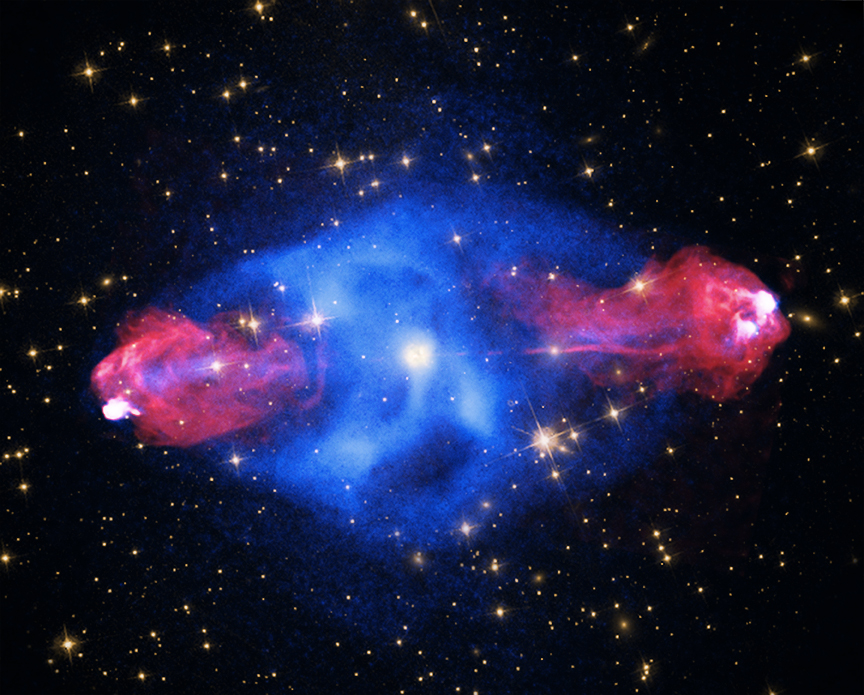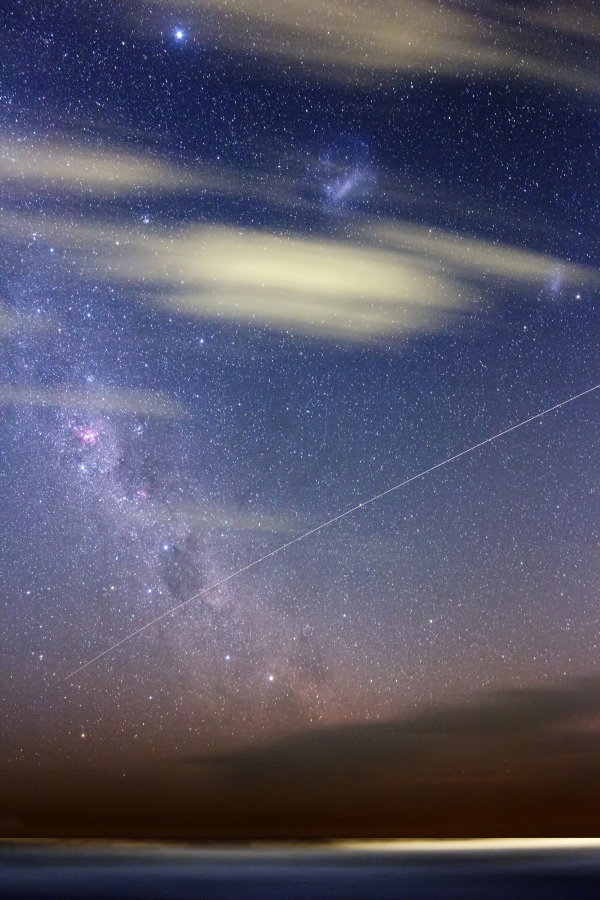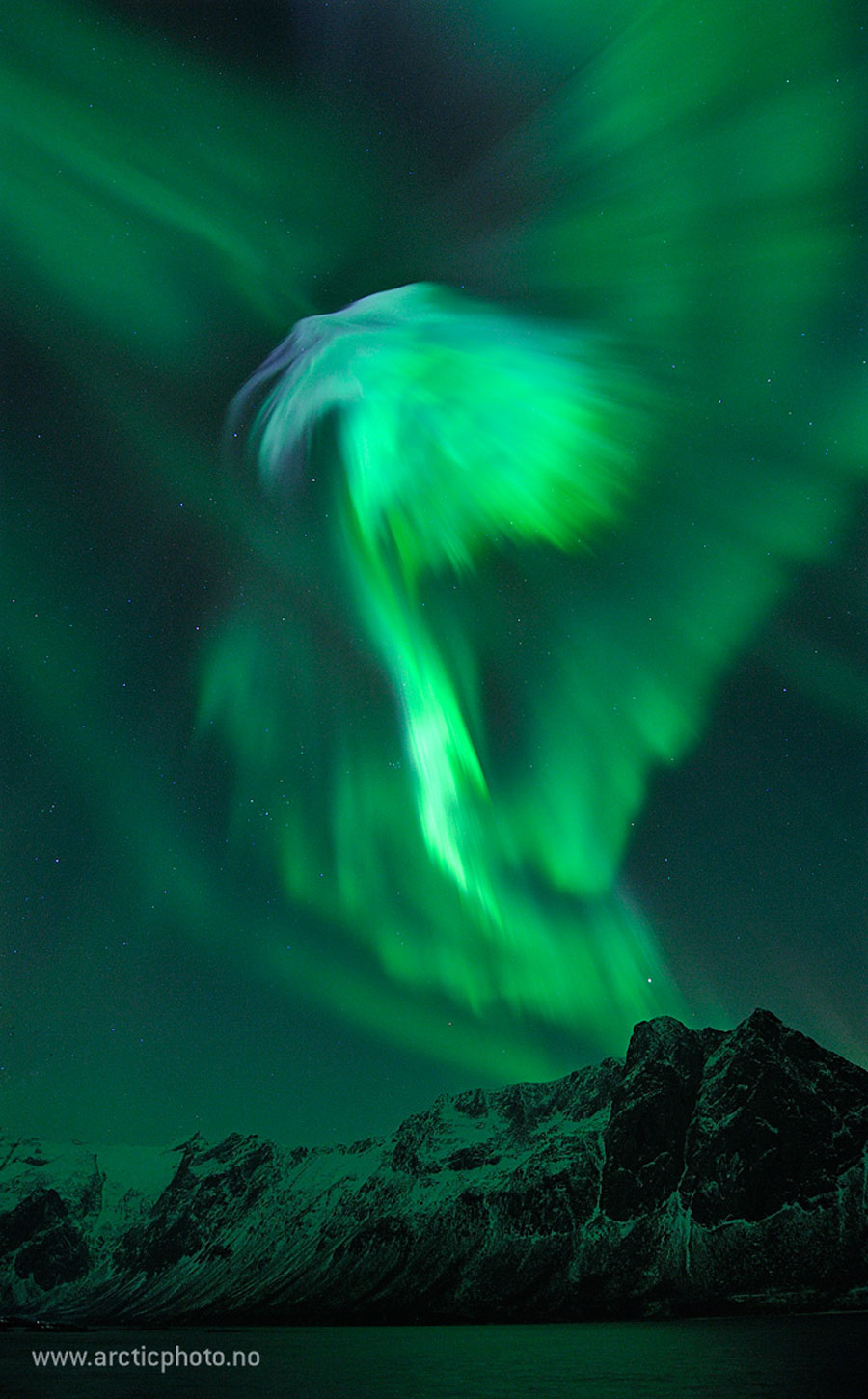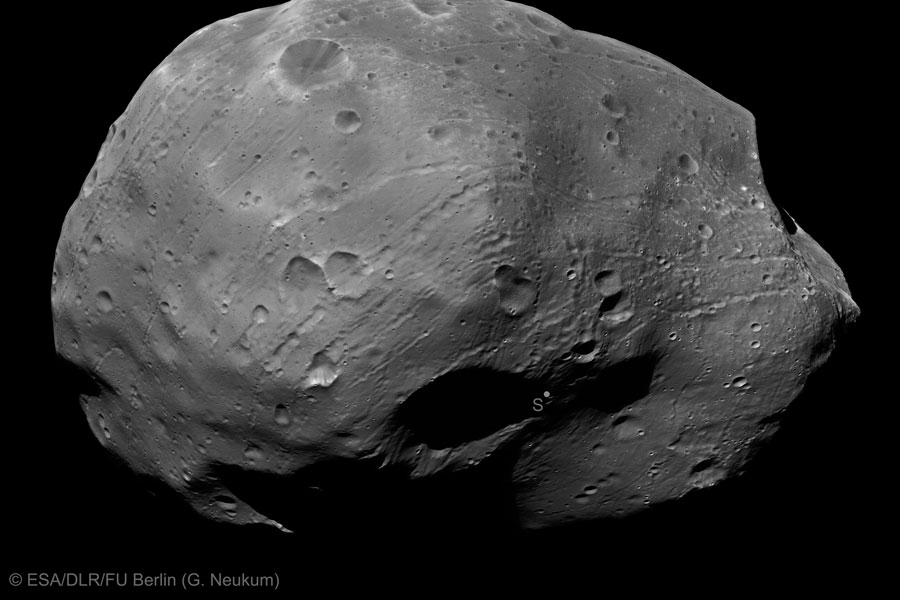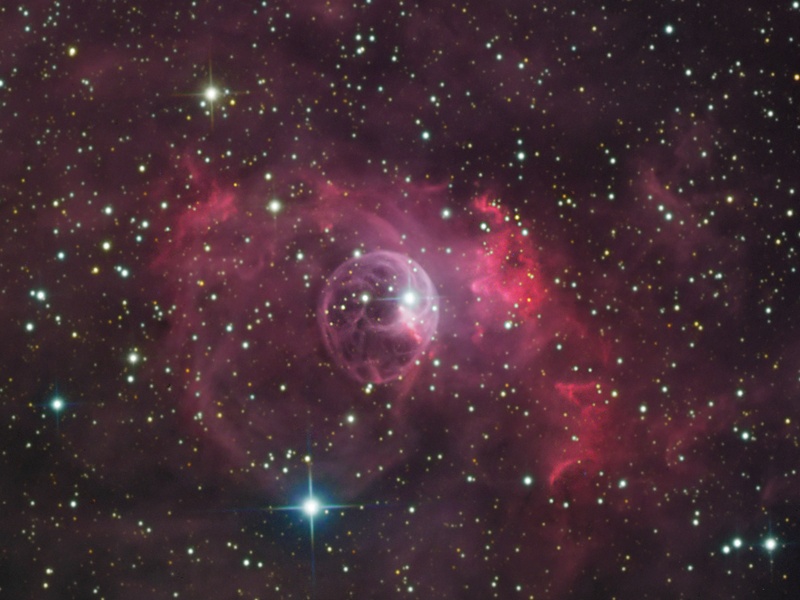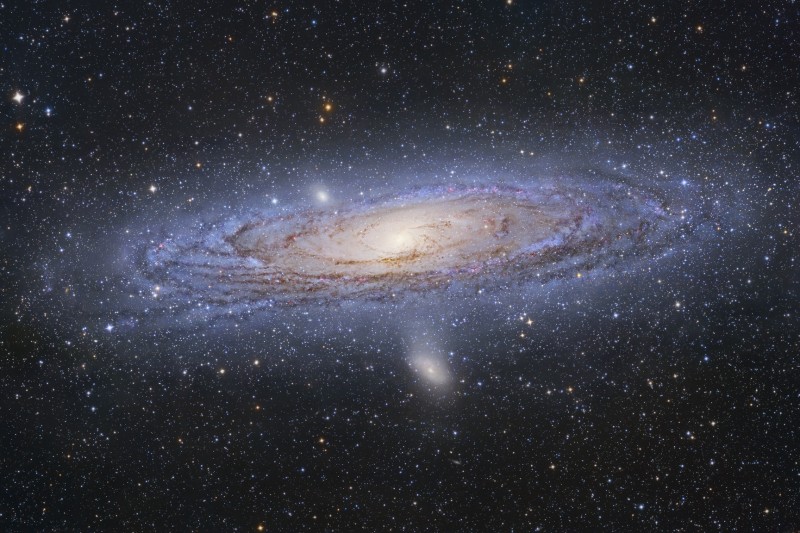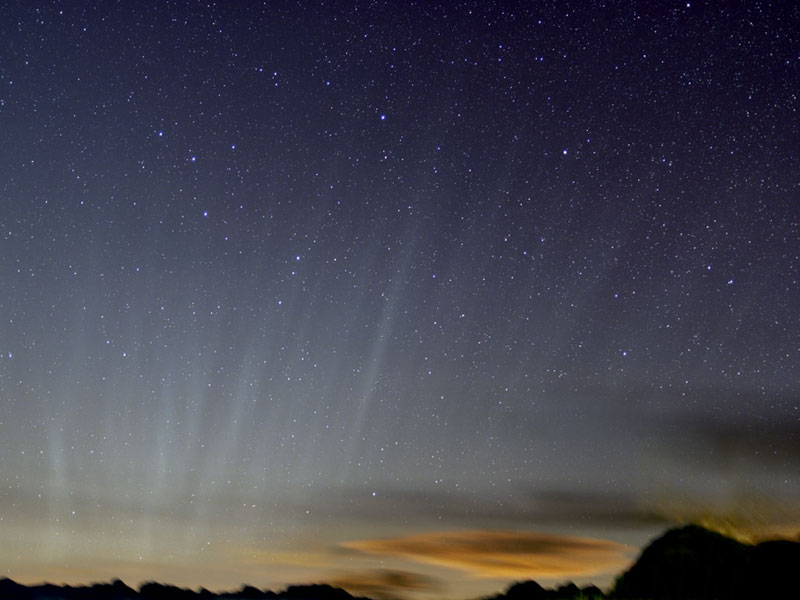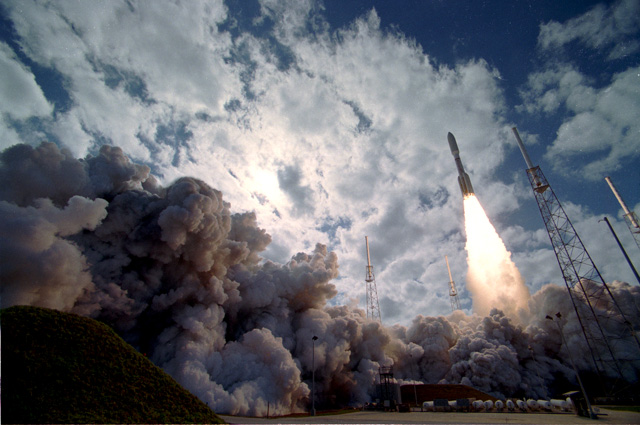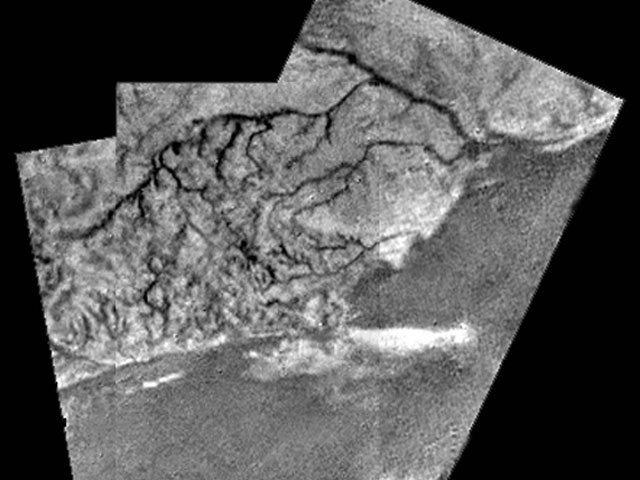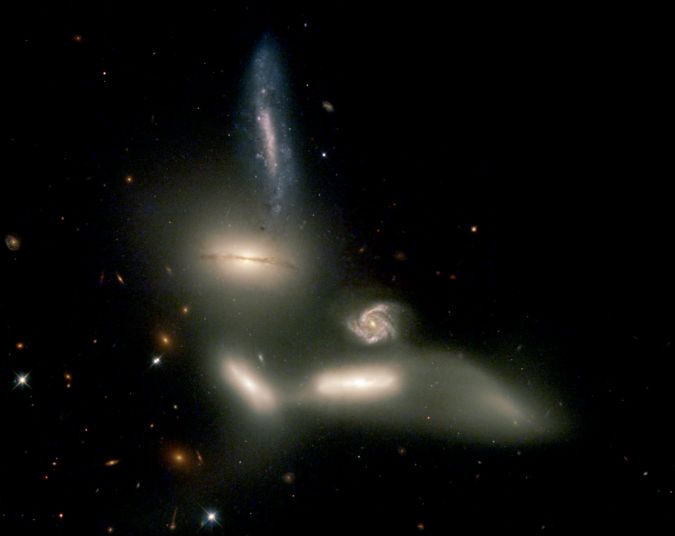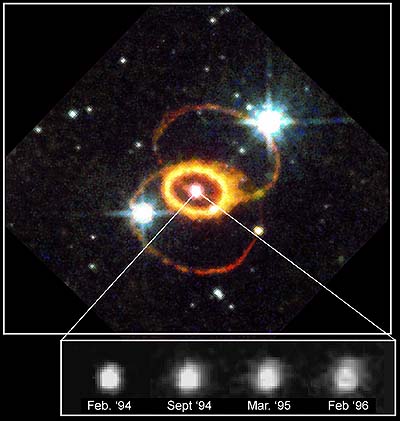| << Previous | Index | Next >> |
2015 Celebrating astronomy in this International Year of Light, the detailed image reveals spectacular active galaxy Cygnus A in light across the electromagnetic spectrum. Incorporating X-ray data (blue) from the orbiting Chandra Observatory, Cygnus A is seen to be a prodigious source of high energy x-rays. But it is actually more famous at the low energy end of the electromagnetic spectrum. One of the brightest celestial sources visible to radio telescopes, at 600 million light-years distant Cygnus A is the closest powerful radio galaxy. Radio emission (red) extends to either side along the same axis for nearly 300,000 light-years powered by jets of relativistic particles emanating from the galaxy's central supermassive black hole. Hot spots likely mark the ends of the jets impacting surrounding cool, dense material. Confined to yellow hues, optical wavelength data of the galaxy from Hubble and the surrounding field in the Digital Sky Survey complete a remarkable multiwavelength view.
2014 Astronomers really don't find supernovae by looking for the arrows. But in this image taken January 23rd, an arrow does point to an exciting, new supernova, now cataloged as SN 2014J, in nearby bright galaxy M82. Located near the Big Dipper in planet Earth's sky, M82 is also known as the Cigar Galaxy, a popular target for telescopes in the northern hemisphere. In fact, SN 2014J was first spotted as an unfamiliar source in the otherwise familiar galaxy by teaching fellow Steve Fossey and astronomy workshop students Ben Cooke, Tom Wright, Matthew Wilde and Guy Pollack at the University College London Observatory on the evening of January 21. M82 is a mere 12 million light-years away (so the supernova explosion did happen 12 million years ago, that light just now reaching Earth), making supernova SN 2014J one of the closest to be seen in recent decades. Spectra indicate it is a Type Ia supernova caused by the explosion of a white dwarf accreting matter from a companion star. By some estimates two weeks away from its maximum brightness, SN 2014J is already the brightest part of M82 and visible in small telescopes in the evening sky.
2013 Clouds on a summer night frame this sea and skyscape, recorded earlier this month near Buenos Aires, Argentina. But planet Earth's clouds are not the only clouds on the scene. Starry clouds and nebulae along the southern hemisphere's summer Milky Way arc above the horizon, including the dark Coal Sack near the Southern Cross and the tantalizing pinkish glow of the Carina Nebula. Both the Large (top center) and Small Magellanic Clouds are also in view, small galaxies in their own right and satellites of the Milky Way up to 200,000 light-years distant. Alpha star of the Carina constellation and second brightest star in Earth's night, Canopus shines above about 300 light-years away. Still glinting in sunlight at an altitude of 400 kilometers, the orbiting International Space Station traces a long streak through the single, 5 minute, star-tracking exposure.
2012 What's that in the sky? An aurora. A large coronal mass ejection occurred on our Sun five days ago, throwing a cloud of fast moving electrons, protons, and ions toward the Earth. Although most of this cloud passed above the Earth, some of it impacted our Earth's magnetosphere and resulted in spectacular auroras being seen at high northern latitudes. Pictured above is a particularly photogenic auroral corona captured last night above Grotfjord, Norway. To some, this shimmering green glow of recombining atmospheric oxygen might appear as a large eagle, but feel free to share what it looks like to you. This round of solar activity is not yet over -- a new and even more powerful solar flare occurred yesterday that might provide more amazing aurora as soon as tonight.
2011 Where on this moon would you land? The moon pictured above is not Earth's moon but Phobos, the closest moon to the planet Mars. Phobos is so close to Mars that it is expected to break up and crash into the red planet within the next 100 million years. Earlier just this year, however, ESA's Mars Express mission took detailed images of the area surrounding Phobos' South Pole. Visible on the small moon's unusually dark surface are many circular craters, long chains of craters, and strange streaks. Large Stickney Crater, which looms on the far right, was also visible in the corresponding North Polar image taken last year. This and other similar images of Phobos are so detailed, resolving items even 10-meters across, that they are useful for examining proposed landing sites of the future Phobos-Grunt mission. The Russian Phobos-Grunt robotic spacecraft is scheduled to launch toward Phobos later this year and return surface samples in 2014.
2010
Click to play embedded YouTube video.
Credit: NASA, Johns Hopkins University Applied Physics Laboratory, Southwest Research Institute
2009 Blown by the wind from a massive star, this interstellar apparition has a surprisingly familiar shape. Cataloged as NGC 7635, it is also known simply as The Bubble Nebula. This colorful telescopic image includes a long exposure through a hydrogen alpha filter to reveal details of the cosmic bubble and its environment. Although it looks delicate, the 10 light-year diameter bubble offers evidence of violent processes at work. Above and right of the Bubble's center is a hot, O-type star, several 100,000 times more luminous and approximately 45 times more massive than the Sun. A fierce stellar wind and intense radiation from that star has blasted out the structure of glowing gas against denser material in a surrounding molecular cloud. The intriguing Bubble Nebula lies a mere 11,000 light-years away toward the boastful constellation Cassiopeia.
2008 The most distant object easily visible to the unaided eye is M31, the great Andromeda Galaxy some two and a half million light-years away. But without a telescope, even this immense spiral galaxy - spanning over 200,000 light years - appears as a faint, nebulous cloud in the constellation Andromeda. In contrast, a bright yellow nucleus, dark winding dust lanes, gorgeous blue spiral arms and star clusters are recorded in this stunning telescopic digital mosaic. While even casual skygazers are now inspired by the knowledge that there are many distant galaxies like M31, astronomers seriously debated this fundamental concept less than 90 years ago. Were these "spiral nebulae" simply outlying components of our own Milky Way Galaxy or were they instead "island universes" -- distant systems of stars comparable to the Milky Way itself? This question was central to the famous Shapley-Curtis debate of 1920, which was later resolved by observations of M31 in favor of Andromeda, island universe.
2007 What's happening over the horizon? Many a sky enthusiast who thought they had seen it all had never seen anything like this. To the surprise of many Northern Hemisphere observers, the tail of Comet McNaught remained visible even after the comet's head set ahead of the Sun. What's more, visible were bright but extremely rare filamentary striae from the comet's expansive dust tail. The cause of dust tail striae are not known for sure, but are possibly related to fragmentation of comet's nucleus. The last comet to show prominent striae was Comet Hale-Bopp in 1997. Pictured above, the tail of Comet McNaught was caught just after sunset last Friday above the Carnic Alps of northern Italy.
2006 Destination: Pluto. The New Horizons spacecraft roared off its launch pad at Cape Canaveral in Florida, USA last week toward adventures in the distant Solar System. The craft is one of the fastest spaceships ever launched by humans, having passed the Moon only nine hours after launch and is on track to buzz Jupiter in early 2007. Even traveling over 75,000 kilometers per hour, the New Horizons craft will not arrive at Pluto until 2015. Pluto is the only remaining planet that has never been visited by a spacecraft or photographed up close. After Pluto, the robot spaceship will visit one or more Kuiper Belt Objects orbiting the Sun even further out than Pluto. Pictured, the New Horizons craft launches into space atop a powerful Atlas V rocket.
2005 Methane rain, evaporating lakes, flowing rivers, and water ice-volcanoes all likely exist on Saturn's moon Titan, according to preliminary analyses of recent images taken by the successful Huygens lander. A snaking and branching riverbed is identified with the dark channel near the top of the above image, while a dark lakebed is identified across the image bottom. Both the riverbed and lakebed were thought to be dry at the time the image was taken but contained a flowing liquid - likely methane - in the recent past. Titan's surface was found to appear strangely similar to Earth even though it is so cold that methane flows and water freezes into rock-hard ice. Although the Huygens probe has now run out of power, the images it returned will likely be studied for decades to come. The Cassini mothership is scheduled to continue to orbit Saturn and return images for several more years.
2004 Looking down from orbit on January 14, ESA's Mars Express spacecraft scanned a 1700 by 65 kilometer swath across Valles Marineris - the Grand Canyon of Mars - with its remarkable High Resolution Stereo Camera. This spectacular picture reconstructs part of the scanned region from the stereo colour image data recording the rugged terrain with a resolution of 12 metres per pixel. Joining Mars Global Surveyor and Mars Odyssey, Mars Express has been orbiting the red planet since December 25th, returning scientific data, acting as a communications relay, and even making coordinated atmospheric observations with NASA's Spirit rover on the surface. The Beagle 2 lander was released from Mars Express making a landing attempt also on December 25th, but no signal has been received so far.
2003 Known as Seyfert's Sextet, this intriguing group of galaxies lies in the head portion of the split constellation Serpens. The sextet actually contains only four interacting galaxies, though. Near the center of this Hubble Space Telescope picture, the small face-on spiral galaxy lies in the distant background and appears only by chance aligned with the main group. Also, the prominent condensation on the far right is likely not a separate galaxy at all, but a tidal tail of stars flung out by the galaxies' gravitational interactions. About 190 million light-years away, the interacting galaxies are tightly packed into a region around 100,000 light-years across, comparable to the size of our own Milky Way galaxy, making this one of the densest known galaxy groups. Bound by gravity, the close-knit group may coalesce into a single large galaxy over the next few billion years.
2002 A small inner moon of Saturn, Enceladus is only about 500 kilometers in diameter. But the cold, distant world does reflect over 90 percent of the sunlight it receives, giving its surface about the same reflectivity as new-fallen snow. Seen here in a mosaic of Voyager 2 images from 1981, Enceladus shows a variety of surface features and very few impact craters - indicating that it is an active world even though this ice moon should have completely cooled off long ago. In fact the fresh, resurfaced appearance of Enceladus suggests that an internal mechanism, perhaps driven by tidal pumping, generates heat and supplies liquid water to geysers or water volcanos. Since Enceladus orbits within the tenuous outer E ring of Saturn, the moon's surface may be kept snow-bright as it is continuously bombarded with icy ring particles. Eruptions on Enceladus itself would in turn supply material to the E ring. Interplanetary ski bums take note: tiny Enceladus has only about one hundredth the surface gravity of planet Earth.
2001 A mere 20,000 light-years from the Sun lies the NGC 3603 star cluster, a resident of the nearby Carina spiral arm of our Milky Way galaxy. Seen here in this recent false-color x-ray image from the Chandra Observatory, NGC 3603 is well known to astronomers as a young cluster in a large galactic star-forming region. The image colors were chosen to show the relative x-ray brightness of the many individual sources present, where green are faint and red to purple hues are bright sources of x-rays. The stars in the cluster were formed in a single "burst" of star formation only one or two million years ago, so the x-rays are believed to come from the massive young stars themselves or from their energetic stellar winds. Since other common galactic sources of x-rays such as supernova remnants and neutron stars represent final stages in the life of a massive star, they are unlikely to be present in such a young cluster. Nearby NGC 3603 is thought to be a convenient example of the star clusters that populate distant starburst galaxies.
2000 In 1787, astronomer William Herschel discovered the Eskimo Nebula. From the ground, NGC 2392 resembles a person's head surrounded by a parka hood. In 2000, just after being fixed, the Hubble Space Telescope imaged the Eskimo Nebula. From space, the nebula displays gas clouds so complex they are not fully understood. The Eskimo Nebula is clearly a planetary nebula, and the gas seen above composed the outer layers of a Sun-like star only 10,000 years ago. The inner filaments visible above are being ejected by strong wind of particles from the central star. The outer disk contains unusual light-year long orange filaments. The Eskimo Nebula lies about 5000 light-years away and is visible with a small telescope in the constellation of Gemini.
1999 This image is part of the first color panoramic view from Venus. It was transmitted by a TV camera on the Soviet Venera 13 lander which parachuted to thesurface on March 1, 1982. Venus' clouds are composed of sulfuric acid droplets while its surface temperature is about 900 degrees Fahrenheit (482 degrees C) at an atmospheric pressure of 92 times that of sea-level on Earth. Despite these harsh conditions, the Venera 13 lander survived long enough to send back a series of images and perform an analysis of the Venusian soil. Part of the lander itself is visible in the lower right portion of the image. An earlier Soviet Venus lander,Venera 7 (1970), was the first spacecraft to return data from the surface of another planet.
1998 Ferdinand Magellan and his crew had plenty of time to study the southern sky during their famous voyage around the world. As a result, two fuzzy cloud-like objects, not visible to northern hemisphere dwellers, are now known as the Clouds of Magellan. These star clouds are small irregular galaxies, satellites of our larger Milky Way spiral galaxy. The Large Magellanic Cloud (LMC) pictured above is only about 180,000 light-years distant - the only known galaxy closer is the Sagittarius Dwarf. Both the LMC and the Small Magellanic Cloud (SMC) are joined to the Milky Way by a stream of cold hydrogen gas. An unusual effect called gravitational lensing has recently been detected in a few LMC stars, and there is hope this could tell us important information about the true composition of our universe.
1997 Ten years ago the most notable supernova of modern times was observed. In February 1987, light reached Earth from a star which exploded in the nearby Large Magellanic Cloud galaxy. Supernova 1987a remains the closest supernova since the invention of the telescope. The explosion catapulted a tremendous amount of gas, light, and neutrinos into interstellar space. When observed by the Hubble Space Telescope (HST) in 1994, large strange rings were discovered whose origin is still mysterious, although thought to have been expelled even before the main explosion. More recent HST observations shown in the inset, however, have uncovered something actually predicted: the expanding fireball from the exploding star. The above high resolution images resolve two blobs flung out from the central explosion.
1996 The image above is part of the Hubble Deep Field and represents humanity's most distant yet optical view of the Universe. Galaxies like colorful pieces of candy fill the field, some as faint as 30th magnitude (about four billion times fainter than stars visible to the unaided eye). The dimmest objects are the most distant galaxies and reveal what the Universe looked like in the extremely distant past, perhaps less than one billion years after the Big Bang. To make the Deep Field image, astronomers selected an uncluttered area of the sky in the constellation Ursa Major (the Big Dipper) and pointed the Hubble Space Telescope at a single spot for 10 days accumulating and combining many separate exposures. With each additional exposure, fainter objects were revealed. The final result can be used to explore the mysteries of galaxy evolution and the infant Universe.
| << Previous | Index | Next >> |
